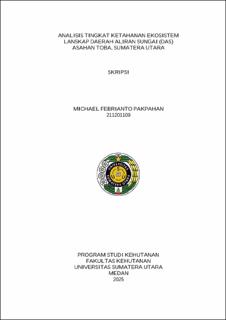| dc.description.abstract | The Asahan Toba Watershed is one of the key hydrological regions in North Sumatra, playing a crucial role as an ecological buffer for Lake Toba and its surrounding areas. To assess the ecosystem's resilience within the watershed, this study integrates both biophysical and anthropogenic approaches. The research aims to analyze the influence of anthropogenic factors on the resilience level of the Asahan Toba watershed landscape.The variables considered in this study include vegetation density (NDVI), road density, educational attainment, and farmers' dependence on the agricultural sector. Data analysis was conducted using Geographic Information System (GIS)-based spatial analysis combined with multiple linear regression to determine the weighted influence of each variable. The results indicate that farmers’ dependence on agriculture has the most substantial impact on ecosystem resilience, contributing 42.3%, followed by road density at 36.2%, and education level at 21.5%. The resulting resilience map shows that areas with very low resilience cover 18,228.31 ha (2.47%), low resilience 143,059.11 ha (19.35%), moderate resilience 367,150.11 ha (49.65%), high resilience 77,622.31 ha (10.50%), and very high resilience 23,267 ha (3.15%). These findings suggest that anthropogenic factors particularly agricultural dependence and infrastructure development play a dominant role in shaping the ecological resilience of the Asahan Toba watershed. This research is expected to serve as a foundation for sustainable watershed management and policy formulation. | en_US |


